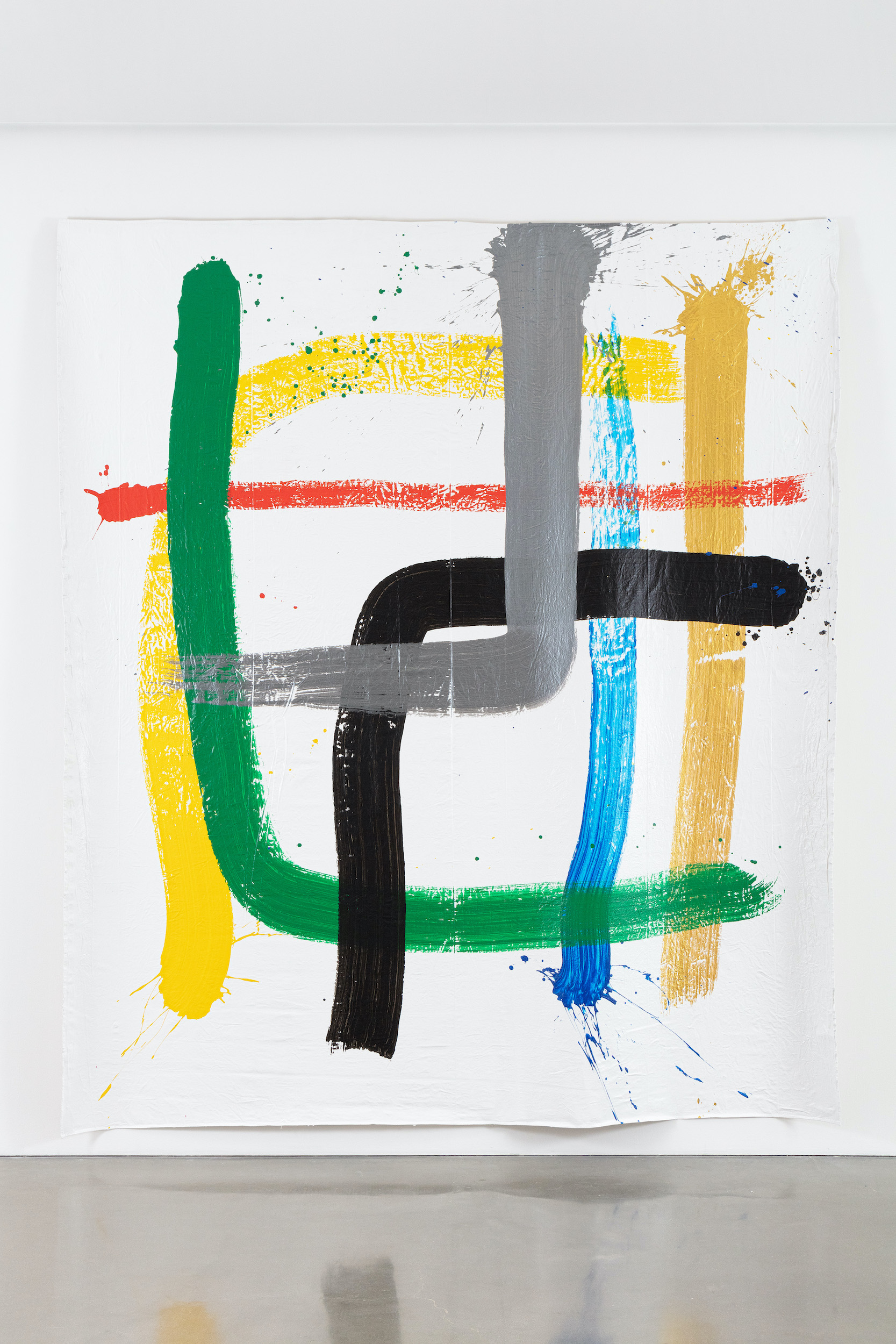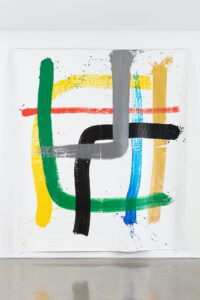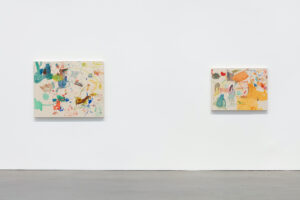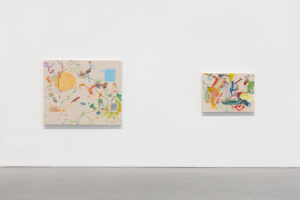 'Primavera A'
2022. Acrylic on canvas. 156 x 137 inches. By Abraham Cruzvillegas courtesy of Regen Projects
'Primavera A'
2022. Acrylic on canvas. 156 x 137 inches. By Abraham Cruzvillegas courtesy of Regen Projects
‘Tres Sonetas’ by Abraham Cruzvillegas, & Sue Williams @ Regen Projects.
Does every new beginning come from some other beginning’s end? In the geometrical reduction of color and lines, Mr. Cruzvillegas triumphs in exalting the necessity for simplicity at Regen Projects. This is especially poignant in our contemporary digital discombobulation at times, where the cloudy shrouds of servers can entangle us into becoming slaves where we are primarily masters of these instrumentation devices ordered to connect us, not destroy us.
This opening is crucial in bridging an understanding between the laity’s preconception of fine art and its genuine progression. And this progression is indeed towards a more supersensuous contemplation of beauty or truth. Yes, we access such a realization of the need for order in our perceptible space through Mr. Cruzvillegas’ extension of his truth to colored forms, but it is in the visibility – or rather invisibility – that draws us nearer toward the cosmic goal of leaving our sensible experiences towards that of the light of the eternal mind. This is to say, his precision in the ordering of his contours reveals to us a masterful consideration of number.

‘Primavera A’
2022. Acrylic on canvas. 156 x 137 inches. By Abraham Cruzvillegas courtesy of Regen Projects
Number ought to be treated sacred, holy, and sublime, just as the Pythagoreans worshipped this invisible permanent form; which can only be recognized by man through the contemplative exercising of his limited mind’s eye toward a position of self-certain knowing. I can know, for instance, the number 1. And from that primal knowing, in the recognition of my mind irreducible, I can count to 2. This is the primal recognition of order. This is the emergence in man of the ability to reason. For with reasoning, we are necessarily agreeing that the appearance of Mr. Cruzvillegas’ contours occur in a sequence. In Primavera A, categorical in the ordering of the lines, we know as matter of fact his blue-stretched explosive end is the last, the invierno of his artwork.
We can evaluate with our mind’s eye the ordering of the painting to arrive at such a reasoned judgment. And it is with this certainty of our mind in agreement with its own positioning of the lines in a connection of movement through space, which permits us the inner pleasure of mathematical beauty; of the mind recognizing a truth that is invisible to the sensual thirstiness of the human eye lens, and, admittedly, its voracious lust for a spring-hail of bodacious color. So much of this thirst is its own recognition of our body’s own primal desires of more and more experience of natural beauty; of the wonder of life itself. And yet, how often such desires lead to dark visions which deviate us from the knowledge of beauty? Of the truth?
It is instructive for us to appreciate the significance of order which is self-contained in mathematical reasoning. And how wondrous it is for Nature to endow us with the ability to reason with objects using our sensible perception of space. That we can count using lines to reveal to a universal audience the universal faculties of reasoning within every human mind, is the exemplification of beauty of the human soul to know its own ordering as right or wrong with its consistency with the order of the World-Soul. It is in the discipline of the necessary agreement with right reason and therefore of righteous conduct in the world, the space where other human minds necessarily occupy, that forms in man the ordering principle of his society.
A just society is one which is moved by just souls. These are souls which are necessarily principled toward the unchanging permanence of true experience. How does a society, then, order all experiences true? Through the celebration of such art as fine, as necessary in society to absorb! And after the absorption is in the experience of the beauty of the Number, that it is indeed Divine in origin. Our society did not need to be ordered this way, as it is now with the superabundance of computing terminals delivering instructions on the human extension. But toward what end? Toward what goal?
What is the goal of every artwork, but to be admired? To be truly known? To be loved? To know, therefore, Nature, and its universally necessary causes upon each of our characters, forms good and bad actors, toward creating a continuum of human movement where there are those who will the world toward more necessary agreement and those who will it toward dysfunction. That such a series of artwork like Primevera will not be truly known immediately by the millions demonstrates the numbering progress that humanity still needs for all to arrive at the best experience of Nature and her unlimited possibilities for creating beauty. It is truly uncountable – a sign worthy of devotion to its and the Number’s First Teacher: God Almighty.

By Sue Williams courtesy Regen Projects.
Meanwhile, speaking of immaterial forms, and that which is impervious to decay, we have the inchoate medley of Ms. Sue William’s imagination outpouring into a copacetic palette in a series of artworks which invariably probe our civilized objects from a radically imaginary perspective. And, no doubt, these perspectives, while not abrasive in confusing our understanding, do certainly imbue ourselves with an openness to the mystique of the genuinely felicitous nature of the whirlwind of objects within each portraiture. Some gives us the feeling of leaving Kansas in a tornado, but not one of maelstrom, but instead a positive abstraction of our worldly experience.

Are these forms reducible? Or are they being investigated, inquired, and inspected through the vital extension of the artist’s mind upon the obsessive details of her magical cacophony of shapes? I am most appreciative of the sharpness of her contours at times, providing some healthy bounded limits to each of her nakedly spaced ideas. Then again, she is ardent to drape her compositions with riverbeds of primary colorful curvature; as well as oblong weighty colors which oh so teasingly play with the need for grabbing our perception of space, if only for a speckle of, say, orange, to protrude out to come join us in our world. These proper deconstruction of elements – both social but as well as principally natural (in the like of colors itself) – gives us greater creative freedom in our imaginary lens, to be plastically expanded in radical perspectives of what is quotidian, mundane, every-day life. This is the visual demonstration of expanding our imaginary limits of human creation, and therefore accomplishes the objective of fine art: to expand the limits of human possibility for true goodness.

